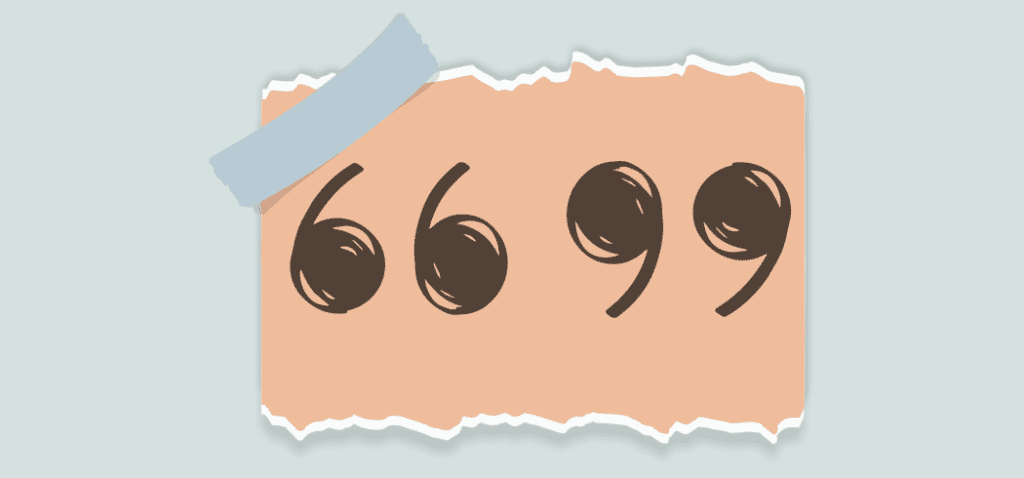When quotes and dialog is used within blocks of text, you need to punctuate them correctly for reader clarity. Where end marks and commas belong can become confusing, which is why we created this quick guide.
Take a look at our simple-to-follow rules when using quotation marks to ensure they are punctuated in a manner that is consistent and makes sense.
What Are Quotation Marks Used For?

Quotation marks are punctuation marks used to indicate the beginning and end of a direct quote within a block of text. They can be used as a double quotation mark to enclose a full quotation or a single quotation mark to enclose quotations within quotations.
Quotation marks allow you to use somebody else’s words, speech, and thoughts in your writing to provide support to your message. They also add interest and signify clarification, and add detail.
Direct quotations represent the exact words of another person or character and require the use of quotation marks. Indirect quotations use only the general idea or meaning of what another person said and can be applied via paraphrasing. These do not require quotation marks.
Quotation Mark Rules and Punctuation
When using quotation marks, it is important to punctuate them correctly and consistently. The following questions are commonly asked to help determine which rules apply to punctuation within or surrounding quotation mark use.
Do You Capitalize the First Word of a Quote?
The only time you capitalize the first word of a quote is when it falls at the beginning of a sentence or is a proper noun.
For example:
- The professor was concerned about his student’s abilities to pass his class, and “shared his frustrations with the head of the department to acquire a prerequisite.”
- “There is no reason to provide added studies when we have free tutoring” was the exact reply he received.
Does a Period Belong Inside or Outside Quotes?
A period always goes inside the quotation marks. Other terminal marks may be found either inside or outside the end quotation mark, and those rules are explained below.
For example:
- My teacher always told us, “I’m not here to be your friend. I’m here to help you succeed.”
Does a Comma Belong Inside or Outside Quotes?
Unlike a period, there are various rules to using a comma with quotation marks. Use these rules and examples to determine comma placement.
Comma Rule #1
Place a comma after an introductory expression before the quotation marks.
For example:
- The students reached out to one another through email, stating, “creating a study circle to review the class lecture notes is one agreed-upon decision to better the class average.“
Comma Rule #2
Use a comma after a quoted sentence, inside the quotation marks, followed by a concluding statement.
For example:
- “The second-period class is in agreement and suggests using Wednesday study hall to get started,” was the reply.
Comma Rule #3
Use a comma inside the quotation marks when followed by an interrupting expression. Then use a comma after the expression, outside the quotation marks, before concluding the quotation.
For example:
- “It has been brought to my attention,” the professor stated at the start of the next class, “that students are concerned about grades and would like to put forth more effort.”
Does a Semicolon or Colon Belong Inside Quotes?
Semicolons and colons are never placed inside quotation marks unless they are part of the direct quote being used.
A colon can introduce a formal quote or tone or can follow a quote.
For example:
- The professor followed his comments in a more formal memo: “due to students’ attention to their struggles, I will be offering extra tutoring each week.”
- He offered “morning and afternoon sessions”: Tuesday, Wednesday, and Thursday.
Semicolons follow the rules of semicolons used both before and after a quote outside the quotation marks.
For example:
- The students were “relieved and glad they had taken responsibility”; they felt a decent grade was now within reach.
Do Question Marks and Exclamation Points Marks Belong Inside Quotes?
When a direct quote includes a question mark or exclamation point, the punctuation will be inside the quotation mark. But, when the question mark or exclamation point is not directly part of the quote, it will be placed outside the quotation marks.
For example:
- “Is it possible to dictate lecture notes into study cards?” one of the students asked.
- You need to review the class book “Physical Sciences For the Ages”!
Quick Reference Guide for Punctuation and Quotation Marks
Period
Inside Quotations Marks
He asked her, “please take the dog for a walk.”
Comma
Outside Quotation Marks: following introductory and interrupting expressions.
Inside Quotation Marks: following quoted materials when followed by a concluding expression.
She replied, “as soon as the rain stops.”
“I think he needs to go now after drinking all that water,” he stated.
Semicolon/Colon
Outside Quotation Marks: unless part of a direct quote.
She rolled her eyes, “Dad, I’ve got this under control,”; highlighting her teenage attitude.
Question Mark
Outside Quotation Marks: unless part of a direct quote.
He glanced at her and asked, “is that really the tone you want to take”?
Exclamation Mark
Outside Quotation Marks: unless part of a direct quote.
She looked at him and whined, “but dad, the rain will ruin my hair”!
Let’s Review
Using proper and consistent punctuation is important when used with quotations. Depending on the punctuation, it may belong either inside or outside the quotation marks. Therefore it is crucial to understand the simple rules surrounding each.
Use the chart provided above for a quick reference to what belongs where and the more detailed explanation and examples to help drive home the point.
